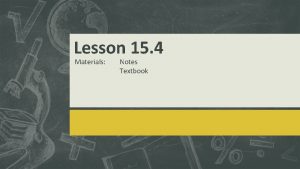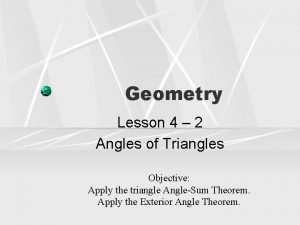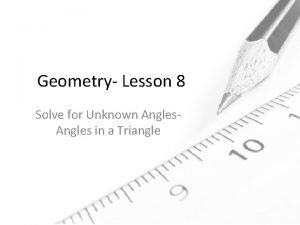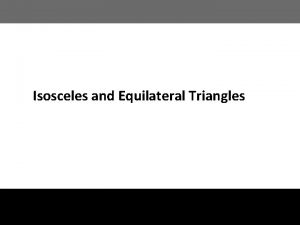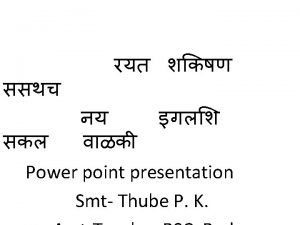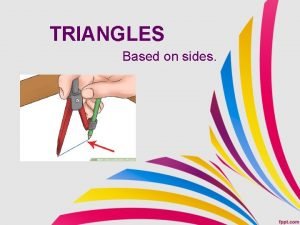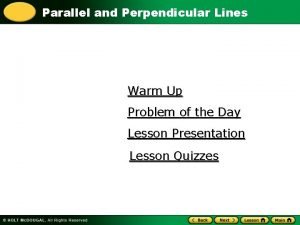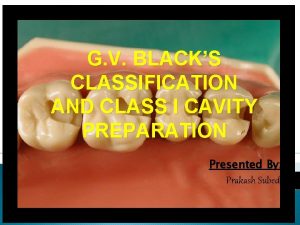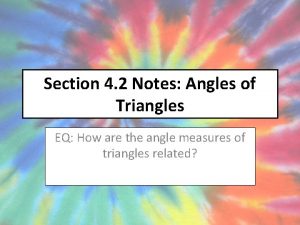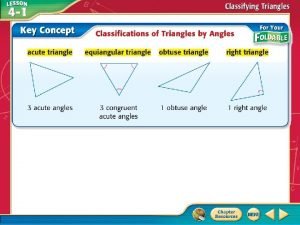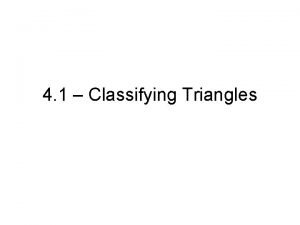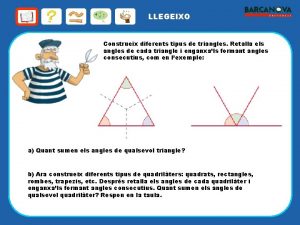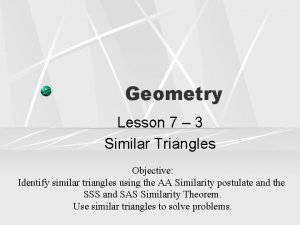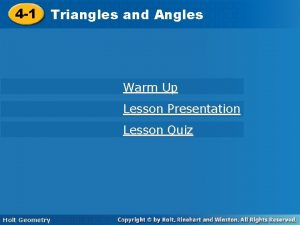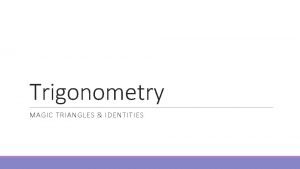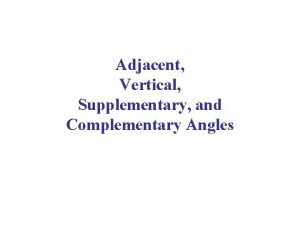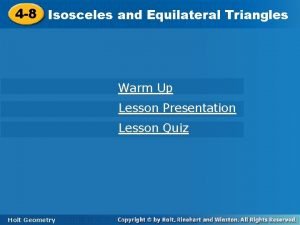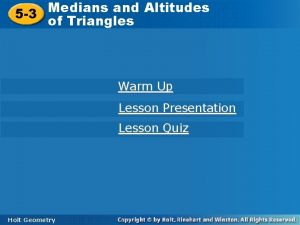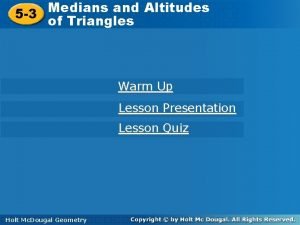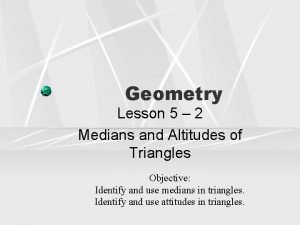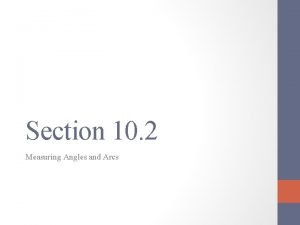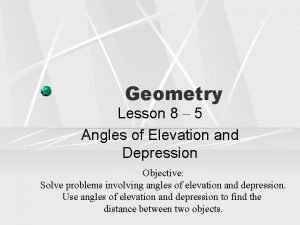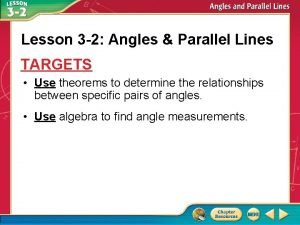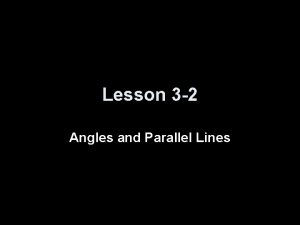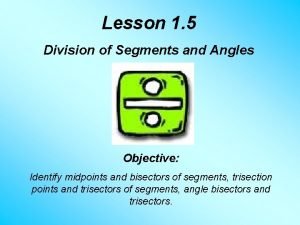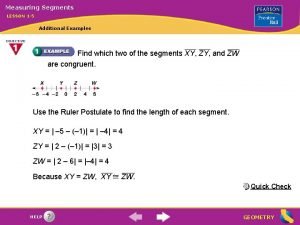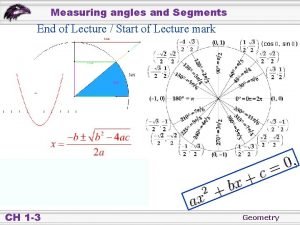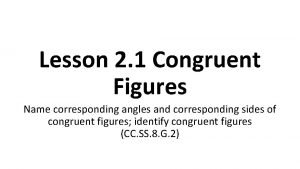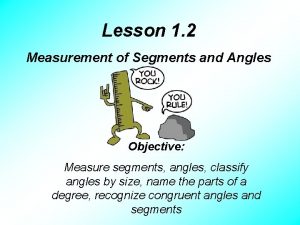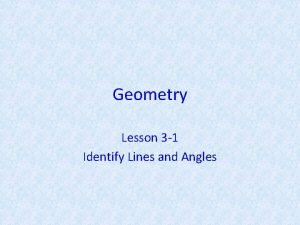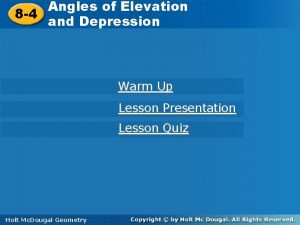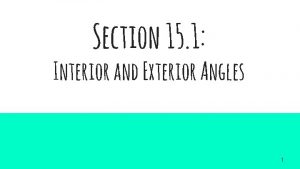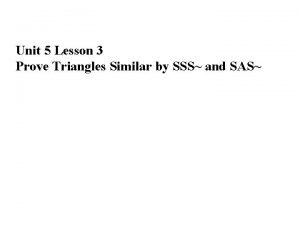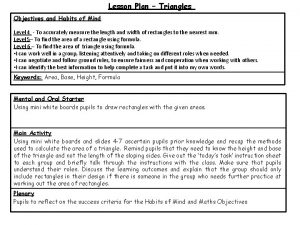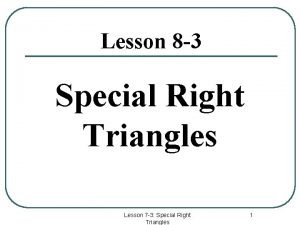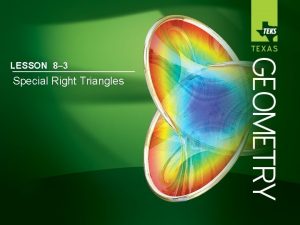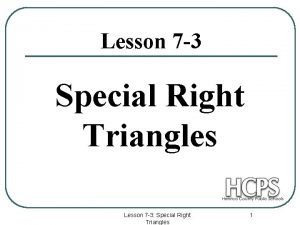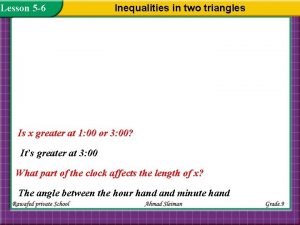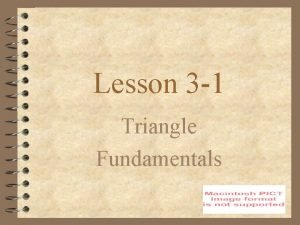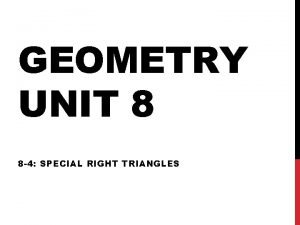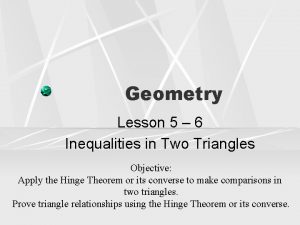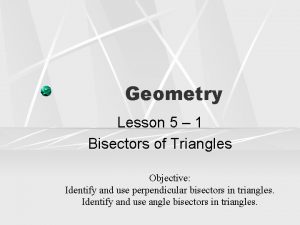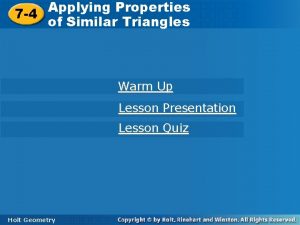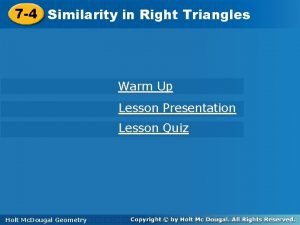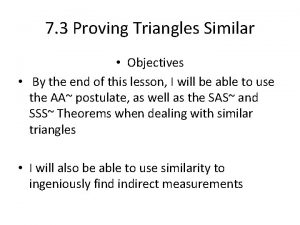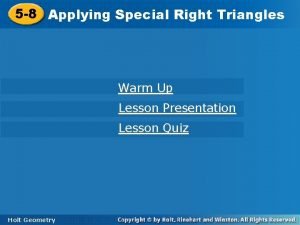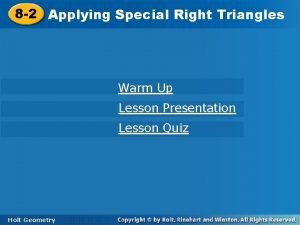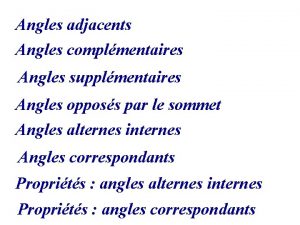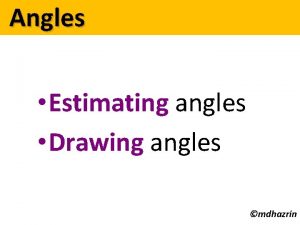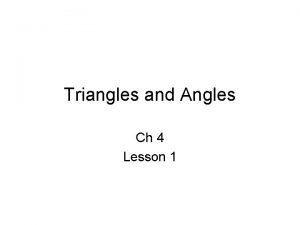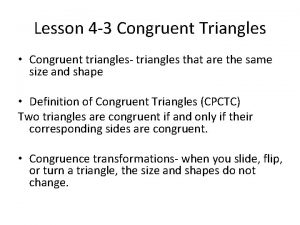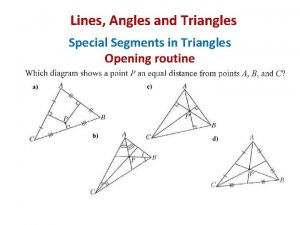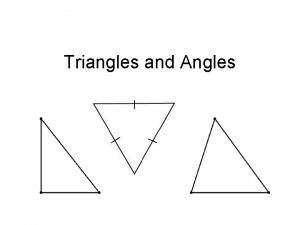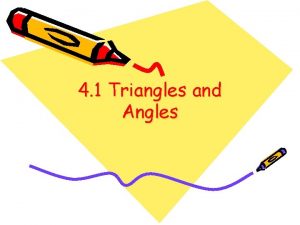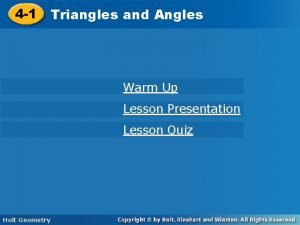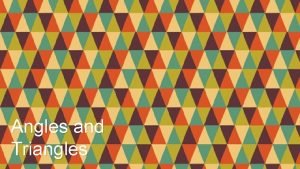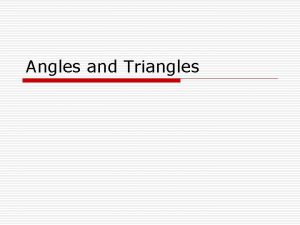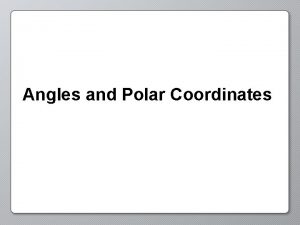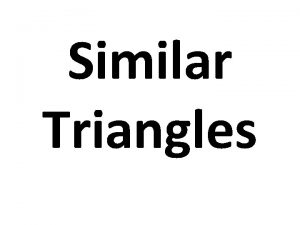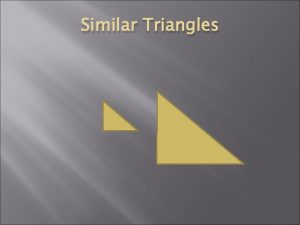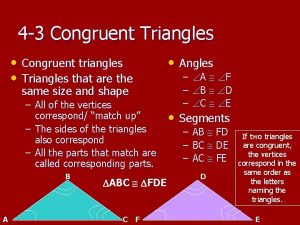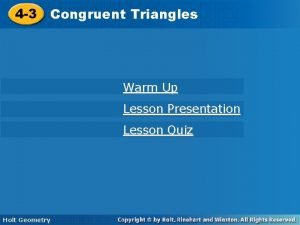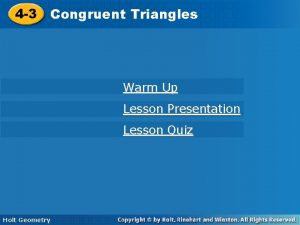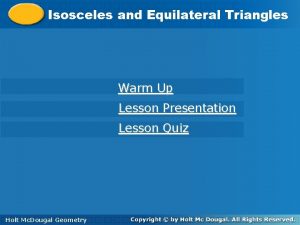4 1 Triangles and Angles Warm Up Lesson

























































- Slides: 57

4 -1 Triangles and Angles Warm Up Lesson Presentation Lesson Quiz Holt Geometry

4. 1 Triangles and Angles Warm Up Classify each angle as acute, obtuse, or right. 1. 3. right 2. acute obtuse 4. If the perimeter is 47, find x and the lengths of the three sides. x = 5; 8; 16; 23

4. 1 Triangles and Angles Objectives Classify triangles by their angle measures and side lengths. Use triangle classification to find angle measures and side lengths. Find the measures of interior and exterior angles of triangles. Apply theorems about the interior and exterior angles of triangles.

4. 1 Triangles and Angles Vocabulary acute triangle equiangular triangle right triangle obtuse triangle equilateral triangle isosceles triangle scalene triangle Corollary Legs Adjacent Exterior Interior Hypotenuse base

4. 1 Triangles and Angles Recall that a triangle ( ) is a polygon with three sides. Triangles can be classified in two ways: by their angle measures or by their side lengths.

4. 1 Triangles and Angles C A B AB, BC, and AC are the sides of A, B, C are the triangle's vertices. ABC.

4. 1 Triangles and Angles In a triangle, two sides sharing a common vertex are Adjacent sides.

4. 1 Triangles and Angles In a right triangle, the two sides making the right angle are called Legs. The side opposite of the right angle is called the Hypothenuse.

4. 1 Triangles and Angles In an isosceles triangle, the two sides that are congruent are called the Legs. The third side is the called the base.

4. 1 Triangles and Angles Triangle Classification By Angle Measures Acute Triangle Three acute angles

4. 1 Triangles and Angles Triangle Classification By Angle Measures Equiangular Triangle Three congruent acute angles

4. 1 Triangles and Angles Triangle Classification By Angle Measures Right Triangle One right angle

4. 1 Triangles and Angles Triangle Classification By Angle Measures Obtuse Triangle One obtuse angle

4. 1 Triangles and Angles Example 1 A: Classifying Triangles by Angle Measures Classify BDC by its angle measures. B is an obtuse angle. So triangle. BDC is an obtuse

4. 1 Triangles and Angles Example 1 B: Classifying Triangles by Angle Measures Classify ABD by its angle measures. ABD and CBD form a linear pair, so they are supplementary. Therefore m ABD + m CBD = 180°. By substitution, m ABD + 100° = 180°. So m ABD = 80°. ABD is an acute triangle by definition.

4. 1 Triangles and Angles Check It Out! Example 1 Classify FHG by its angle measures. EHG is a right angle. Therefore m EHF +m FHG = 90°. By substitution, 30°+ m FHG = 90°. So m FHG = 60°. FHG is an equiangular triangle by definition.

4. 1 Triangles and Angles Triangle Classification By Side Lengths Equilateral Triangle Three congruent sides

4. 1 Triangles and Angles Triangle Classification By Side Lengths Isosceles Triangle At least two congruent sides

4. 1 Triangles and Angles Triangle Classification By Side Lengths Scalene Triangle No congruent sides

4. 1 Triangles and Angles Remember! When you look at a figure, you cannot assume segments are congruent based on appearance. They must be marked as congruent.

4. 1 Triangles and Angles When the sides of the triangle are extended, the original angles are the interior angles. The angles that are adjacent (next to) the interior angles are the exterior angles.

4. 1 Triangles and Angles

4. 1 Triangles and Angles An auxiliary line is a line that is added to a figure to aid in a proof. An auxiliary line used in the Triangle Sum Theorem

4. 1 Triangles and Angles

4. 1 Triangles and Angles A corollary is a theorem whose proof follows directly from another theorem. Here are two corollaries to the Triangle Sum Theorem.

4. 1 Triangles and Angles An auxiliary line is a line that is added to a figure to aid in a proof. An auxiliary line used in the Triangle Sum Theorem

4. 1 Triangles and Angles Example 1 A: Application After an accident, the positions of cars are measured by law enforcement to investigate the collision. Use the diagram drawn from the information collected to find m XYZ + m YZX + m ZXY = 180° m XYZ + 40 + 62 = 180 m XYZ + 102 = 180 m XYZ = 78° Sum. Thm Substitute 40 for m YZX and 62 for m ZXY. Simplify. Subtract 102 from both sides.

4. 1 Triangles and Angles Example 1 B: Application After an accident, the positions of cars are measured by law enforcement to investigate the collision. Use the diagram drawn from the information collected to find m YWZ. 118° Step 1 Find m WXY. m YXZ + m WXY = 180° 62 + m WXY = 180 m WXY = 118° Lin. Pair Thm. and Add. Post. Substitute 62 for m YXZ. Subtract 62 from both sides.

4. 2 Congruence and Triangles Example 1 B: Application Continued After an accident, the positions of cars are measured by law enforcement to investigate the collision. Use the diagram drawn from the information collected to find m YWZ. 118° Step 2 Find m YWZ. m YWX + m WXY + m XYW = 180° Sum. Thm m YWX + 118 + 12 = 180 Substitute 118 for m WXY and 12 for m XYW. m YWX + 130 = 180 Simplify. m YWX = 50° Subtract 130 from both sides.

4. 1 Triangles and Angles Check It Out! Example 1 Use the diagram to find m MJK + m JKM + m KMJ = 180° m MJK + 104 + 44= 180 Sum. Thm Substitute 104 for m JKM and 44 for m KMJ. m MJK + 148 = 180 Simplify. m MJK = 32° Subtract 148 from both sides.

4. 1 Triangles and Angles A corollary is a theorem whose proof follows directly from another theorem. Here are two corollaries to the Triangle Sum Theorem.

4. 1 Triangles and Angles Example 2: Finding Angle Measures in Right Triangles One of the acute angles in a right triangle measures 2 x°. What is the measure of the other acute angle? Let the acute angles be A and B, with m A = 2 x°. m A + m B = 90° 2 x + m B = 90 Acute s of rt. are comp. Substitute 2 x for m A. m B = (90 – 2 x)° Subtract 2 x from both sides.

4. 1 Triangles and Angles Check It Out! Example 2 a The measure of one of the acute angles in a right triangle is 63. 7°. What is the measure of the other acute angle? Let the acute angles be A and B, with m A = 63. 7°. m A + m B = 90° Acute s of rt. 63. 7 + m B = 90 Substitute 63. 7 for m A. m B = 26. 3° are comp. Subtract 63. 7 from both sides.

4. 1 Triangles and Angles Check It Out! Example 2 b The measure of one of the acute angles in a right triangle is x°. What is the measure of the other acute angle? Let the acute angles be A and B, with m A = x°. m A + m B = 90° x + m B = 90 m B = (90 – x)° Acute s of rt. are comp. Substitute x for m A. Subtract x from both sides.

4. 2 Congruence and Triangles Check It Out! Example 2 c The measure of one of the acute angles in a right triangle is 48 2°. What is the measure of 5 the other acute angle? 2° Let the acute angles be A and B, with m A = 48 5. m A + m B = 90° 2 48 5 + m B = 90 m B = 3° 41 5 Acute s of rt. Substitute 48 Subtract 48 are comp. 2 for m A. 5 2 from both sides. 5

4. 2 Congruence and Triangles The interior is the set of all points inside the figure. The exterior is the set of all points outside the figure. Exterior Interior

4. 1 Triangles and Angles An interior angle is formed by two sides of a triangle. An exterior angle is formed by one side of the triangle and extension of an adjacent side. 4 is an exterior angle. Exterior Interior 3 is an interior angle.

4. 1 Triangles and Angles Each exterior angle has two remote interior angles. A remote interior angle is an interior angle that is not adjacent to the exterior angle. 4 is an exterior angle. Exterior Interior The remote interior angles of 4 are 1 and 2. 3 is an interior angle.

4. 1 Triangles and Angles

4. 1 Triangles and Angles Example 3: Applying the Exterior Angle Theorem Find m B. m A + m B = m BCD Ext. Thm. 15 + 2 x + 3 = 5 x – 60 Substitute 15 for m A, 2 x + 3 for m B, and 5 x – 60 for m BCD. 2 x + 18 = 5 x – 60 78 = 3 x Simplify. Subtract 2 x and add 60 to both sides. Divide by 3. 26 = x m B = 2 x + 3 = 2(26) + 3 = 55°

Check It Out! Example 3 Find m ACD = m A + m B Ext. Thm. 6 z – 9 = 2 z + 1 + 90 Substitute 6 z – 9 for m ACD, 2 z + 1 for m A, and 90 for m B. 6 z – 9 = 2 z + 91 Simplify. 4 z = 100 Subtract 2 z and add 9 to both sides. Divide by 4. z = 25 m ACD = 6 z – 9 = 6(25) – 9 = 141°

4. 1 Triangles and Angles Example 2 A: Classifying Triangles by Side Lengths Classify EHF by its side lengths. From the figure, isosceles. . So HF = 10, and EHF is

4. 1 Triangles and Angles Example 2 B: Classifying Triangles by Side Lengths Classify EHG by its side lengths. By the Segment Addition Postulate, EG = EF + FG = 10 + 4 = 14. Since no sides are congruent, EHG is scalene.

4. 1 Triangles and Angles Check It Out! Example 2 Classify ACD by its side lengths. From the figure, isosceles. . So AC = 15, and ACD is

4. 1 Triangles and Angles Example 3: Using Triangle Classification Find the side lengths of JKL. Step 1 Find the value of x. Given. Def. of segs. Substitute (4 x – 10. 7) for 4 x – 10. 7 = 2 x + 6. 3 JK and (2 x + 6. 3) for KL. JK = KL 2 x = 17. 0 x = 8. 5 Add 10. 7 and subtract 2 x from both sides. Divide both sides by 2.

4. 1 Triangles and Angles Example 3 Continued Find the side lengths of Step 2 Substitute 8. 5 into the expressions to find the side lengths. JK = 4 x – 10. 7 = 4(8. 5) – 10. 7 = 23. 3 KL = 2 x + 6. 3 = 2(8. 5) + 6. 3 = 23. 3 JL = 5 x + 2 = 5(8. 5) + 2 = 44. 5 JKL.

4. 1 Triangles and Angles Check It Out! Example 3 Find the side lengths of equilateral FGH. Step 1 Find the value of y. Given. FG = GH = FH Def. of segs. Substitute 3 y – 4 = 2 y + 3 (3 y – 4) for FG and (2 y + 3) for GH. y=7 Add 4 and subtract 2 y from both sides.

4. 1 Triangles and Angles Check It Out! Example 3 Continued Find the side lengths of equilateral FGH. Step 2 Substitute 7 into the expressions to find the side lengths. FG = 3 y – 4 = 3(7) – 4 = 17 GH = 2 y + 3 = 2(7) + 3 = 17 FH = 5 y – 18 = 5(7) – 18 = 17

4. 1 Triangles and Angles Example 4: Application A steel mill produces roof supports by welding pieces of steel beams into equilateral triangles. Each side of the triangle is 18 feet long. How many triangles can be formed from 420 feet of steel beam? The amount of steel needed to make one triangle is equal to the perimeter P of the equilateral triangle. P = 3(18) P = 54 ft

4. 1 Triangles and Angles Example 4: Application Continued A steel mill produces roof supports by welding pieces of steel beams into equilateral triangles. Each side of the triangle is 18 feet long. How many triangles can be formed from 420 feet of steel beam? To find the number of triangles that can be made from 420 feet of steel beam, divide 420 by the amount of steel needed for one triangle. 420 54 = 7 79 triangles There is not enough steel to complete an eighth triangle. So the steel mill can make 7 triangles from a 420 ft. piece of steel beam.

4. 1 Triangles and Angles Check It Out! Example 4 a Each measure is the side length of an equilateral triangle. Determine how many 7 in. triangles can be formed from a 100 in. piece of steel. The amount of steel needed to make one triangle is equal to the perimeter P of the equilateral triangle. P = 3(7) P = 21 in.

4. 1 Triangles and Angles Check It Out! Example 4 a Continued Each measure is the side length of an equilateral triangle. Determine how many 7 in. triangles can be formed from a 100 in. piece of steel. To find the number of triangles that can be made from 100 inches of steel, divide 100 by the amount of steel needed for one triangle. 100 7 = 2 14 7 triangles There is not enough steel to complete a fifteenth triangle. So the manufacturer can make 14 triangles from a 100 in. piece of steel.

4. 1 Triangles and Angles Check It Out! Example 4 b Each measure is the side length of an equilateral triangle. Determine how many 10 in. triangles can be formed from a 100 in. piece of steel. The amount of steel needed to make one triangle is equal to the perimeter P of the equilateral triangle. P = 3(10) P = 30 in.

4. 1 Triangles and Angles Check It Out! Example 4 b Continued Each measure is the side length of an equilateral triangle. Determine how many 10 in. triangles can be formed from a 100 in. piece of steel. To find the number of triangles that can be made from 100 inches of steel, divide 100 by the amount of steel needed for one triangle. 100 10 = 10 triangles The manufacturer can make 10 triangles from a 100 in. piece of steel.

4. 1 Triangles and Angles Lesson Quiz I Classify each triangle by its angles and sides. 1. MNQ acute; equilateral 2. NQP obtuse; scalene 3. MNP acute; scalene 4. Find the side lengths of the triangle. 29; 23

4. 1 Triangles and Angles Lesson Quiz: Part II 5. The measure of one of the acute angles in a right triangle is 56 2 °. What is the measure of the other acute angle? 3 1 33 3 ° 6. Find m ABD. 124°

4. 1 Triangles and Angles Lesson Quiz: Part III 7. The diagram is a map showing John's house, Kay's house, and the grocery store. What is the angle the two houses make with the store? 30°
 Vertical angles are
Vertical angles are Segment relationships in circles lesson 15-4
Segment relationships in circles lesson 15-4 Lesson 4-2 angles of triangles answer key
Lesson 4-2 angles of triangles answer key Find the unknown labeled angles
Find the unknown labeled angles Isosceles triangle algebra
Isosceles triangle algebra Topic 2 angles of triangles
Topic 2 angles of triangles Triangles types and angles
Triangles types and angles All triangles have equal sides and angles true or false
All triangles have equal sides and angles true or false Angles & lines unit warm ups
Angles & lines unit warm ups Angles & lines unit warm ups
Angles & lines unit warm ups G.v. black's classification
G.v. black's classification Angles in triangles section 4-2
Angles in triangles section 4-2 Classify point c
Classify point c Triangles classified by angles
Triangles classified by angles Tipus de triangles segons els costats i els angles
Tipus de triangles segons els costats i els angles Topic 2 angles of triangles
Topic 2 angles of triangles Determine similar triangles angles
Determine similar triangles angles 4-1 angles of triangles
4-1 angles of triangles Trig magic triangles
Trig magic triangles Supplementary angles are adjacent angles
Supplementary angles are adjacent angles Right triangle trigonometry examples
Right triangle trigonometry examples 11-1 area of parallelograms
11-1 area of parallelograms 4-8 isosceles and equilateral triangles
4-8 isosceles and equilateral triangles 5-5 medians and altitudes
5-5 medians and altitudes 4-8 isosceles and equilateral triangles
4-8 isosceles and equilateral triangles Lesson 4-6 isosceles and equilateral triangles
Lesson 4-6 isosceles and equilateral triangles 5-3 problem solving medians and altitudes of triangles
5-3 problem solving medians and altitudes of triangles Altitude geometry
Altitude geometry Isosceles and equilateral triangles 4-5
Isosceles and equilateral triangles 4-5 Lesson 10-2 measuring angles and arcs answers
Lesson 10-2 measuring angles and arcs answers 8-5 angles of elevation and depression answer key
8-5 angles of elevation and depression answer key Congruent angles on parallel lines
Congruent angles on parallel lines Section 3-2 angles and parallel lines
Section 3-2 angles and parallel lines Division of segments and angles
Division of segments and angles Lesson 8-4 angles of elevation and depression answer key
Lesson 8-4 angles of elevation and depression answer key Measuring segments quick check
Measuring segments quick check 1-1 lesson quiz measuring segments and angles
1-1 lesson quiz measuring segments and angles Lesson 2-1 angles and congruence
Lesson 2-1 angles and congruence Lesson 1 hands on angles
Lesson 1 hands on angles Geometry
Geometry Lesson 8-4 angles of elevation and depression
Lesson 8-4 angles of elevation and depression 15.1 interior and exterior angles
15.1 interior and exterior angles Unit 3 similarity lesson 3 proving triangles similar
Unit 3 similarity lesson 3 proving triangles similar Lesson 3 triangles answers
Lesson 3 triangles answers Classifying triangles lesson plan
Classifying triangles lesson plan Special right triangles activity
Special right triangles activity Lesson 8-3 special right triangles
Lesson 8-3 special right triangles Special right triangles
Special right triangles 5-6 skills practice inequalities involving two triangles
5-6 skills practice inequalities involving two triangles Lesson 3 classify triangles
Lesson 3 classify triangles 8-4 special right triangles
8-4 special right triangles Lesson 5-6 inequalities in two triangles answer key
Lesson 5-6 inequalities in two triangles answer key 5-1 bisectors of triangles
5-1 bisectors of triangles Lesson 7-4 applying properties of similar triangles
Lesson 7-4 applying properties of similar triangles 7-4 lesson quiz similarity in right triangles
7-4 lesson quiz similarity in right triangles 7-4 similar triangles sss and sas similarity
7-4 similar triangles sss and sas similarity Special right triangles
Special right triangles 8-2 practice special right triangles form g
8-2 practice special right triangles form g

